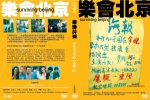Near the city center of Zhangye – located along the ancient Silk Road – stands a white statue wearing a Roman robe, and underneath it spells the name “Ma Ke Bo Luo”. Next to it is a road named the European-Style Street.

The Roman characters inscribed underneath the statue are: "Ma Ke Bo Luo", which is Marco Polo's name in Chinese pinyin.
Both the statue and the street are in honor of the famed Italian traveler Marco Polo, who had visited Zhangye over 700 years ago; and the Italian mentioned at length in his travelogue about the City’s main attraction – a giant reclining Buddha measuring 35 meters.
But the European-Style Street is perhaps the tackiest part of the otherwise lovely City. There’s nothing Europe about the street except the endless Roman pillars supporting the shop houses lining the street, all adorn with huge Chinese signboards.
The street, however, has turned into a happening spot for the slow-pace City well known for its ancient wooden pagoda and giant Buddha temple. Cafes, bars and pubs, and swanky eateries flourished, and the clientele are mostly the yuppies in town.
While the young and trendy frequent the European-Style Street at night, the City’s older residents prefer to rise early each day and exercise in a square fronting the ancient wooden pagoda.
Just a short distance away from the Pagoda is the over-thousand-year-old giant reclining Buddha temple, which had once impressed Marco Polo.
However, the locals hardly go to the temple for prayer unless on special occasions, guess the entrance fee of 41 yuan (approx 4 Euro) is a bit too much even for the faithful.
The Silk Road, apart from being an ancient trade route, was also a path for Buddhism development in ancient China. Today, ruins of Buddhism temples, grottoes, and stupas have been refurbished for big tourist money.
Yesterday, I went to the countryside to check out the Mati Cave Temple with some 1,600 years of history. It is now located in an area named the Scenic Park of Mati Temple, covering an area of some 100 square km, with the beautiful Qilian snow mountain as its backdrop.
A few years ago, when the local government decided to turn the area into a tourism spot, villagers and nomads (mainly of Tibetan ethnicity) roaming the grassland there were relocated to a new village outside the now gated compound of Mati Scenic Park.
“The government wants to turn it into an eco-tourism site, village settlements and grazing herds may spoil the natural environment, so we move out,” says a villager who has been given a brick house in the new village, and now runs a grocery shop.
In place of those abandoned age-old human settlements, the Mati Scenic Park has now set up an area of tourist service center – double-storey shop lots, cultural performance hall, and nomad tents for accommodation.
Tourism development has spurred new economic activities for villagers, many of whom run restaurants, souvenir shops, tourist hostels, horse riding services, bus services, tour guides, cultural dancers and singers, etc.

Locals dressed in Tibetan and Yugu minorities' traditional costume staging cultural performances for tourists.
The Buddhism heritage site has become a source of income and means to improve quality of life, and villagers pay their tributes to the temples in Mati Park on special occasions.
According to the chief monk of the Thousand-Buddha Cave Temple – a Han-tradition Buddhist temple located inside the Park, after years of downturn and neglect (religion was under attack during the early rule of Communism) , the temple has seen more believers in recent years. The temple is even getting a new coat of paint during my visit.
“There are some young, educated and middle class people who come in search of religion, something alien during their growing up years; and there are some old people who return to the old tradition after abandoning it for decades,” the chief monk says.
The number of resident monks is small though, about seven to eight of them, and there are a dozen of faithful, mainly senior citizens, who stay in the temple during the summer, learning Buddhism text and doing voluntary work for the temple, like cleaning, planting vegetables, selling Buddhism trinkets and books to tourists.
A 78-year-old lady staying in the temple says she only converted to Buddhism when she was about 60, none of her family member believes in it. She reasons: “My children and grandchildren are all grown up now and living well, there’s nothing to worry anymore except my afterlife.”
The monks and long-term residence in the temple nearly all come from the nearby city of Zhangye, some 60km away. The increasing number of new believers in recent years also made up of more urbanites than rural folks.
Is there a connection between economic well-being and the revival of the religion? May be, says the chief monk, when the people are well fed and struggling less for livelihood, they have more resources to ponder on the spiritual side of life.
June 10, 2010
(note: for more photos on Zhangye City, the Giant Reclining Buddha Temple, and the Mati Cave Temple, please refer to photo essay: 金张掖和马蹄寺)




Leave a comment